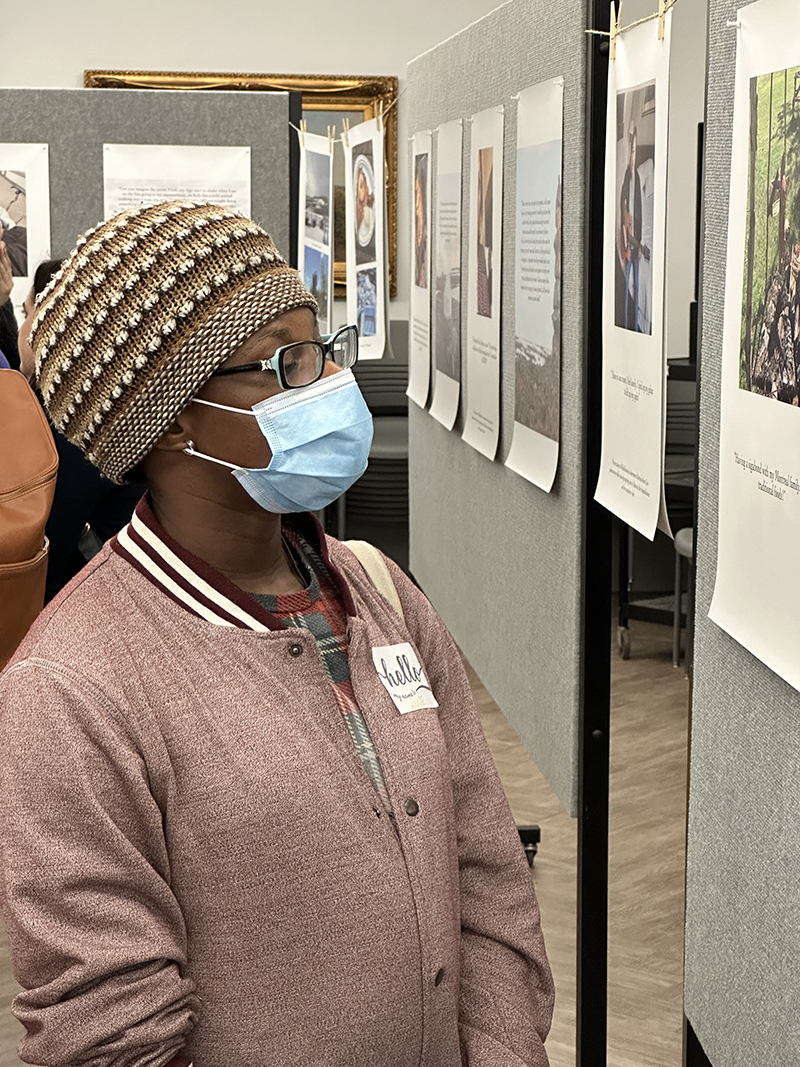"Voices from the Heart": Honouring Indigenous stories
An innovative initiative between the MUHC and the Cree Board of Health and Social Services of James Bay aims to improve the quality of care for Indigenous patients.
On Tuesday, November 19, Indigenous and non-Indigenous people gathered at the “Voices from the Heart” exhibition in Livingston Hall at the Montreal General Hospital. It was a truly memorable event, highlighting the powerful stories of Indigenous patients, their resilience, and their creativity. A research project using the Photovoice research method and a continuous quality improvement project known as MEPA (Mesure de l’expérience patient autochtone) was conducted by these two teams. The goal is to build trust-based relationships to better understand patient experiences and work with them to improve the quality of care.
A better measurement of the Indigenous patient experience
This is an innovative initiative between the Quality Improvement Office, the Research Institute of the McGill University Health Centre, and the Cree Board of Health and Social Services of James Bay (CCSSSBJ). One of the starting points of the project was the need to accurately measure the experience of Indigenous patients and, therefore, encourage their expression.
“Today, it’s no longer about defining the research criteria ourselves and imposing them top-down. The criteria must come from the communities involved,” says Dr. Romina Pace, Internist and Researcher at the Institute. “The idea of using photography was actually suggested to us by the CCSSSBJ, who saw it as an excellent way to initiate authentic dialogue. That’s when the project began, with the Patient Experience Office committee, which deals specifically with the Indigenous.”
Photography as a means of self-expression
“The idea was to use photography as a starting point to get patients to share their concerns and experiences, allowing us to better understand how they perceive the care provided in our large urban hospital centres, which are typically so distant from them, both physically and culturally,” she adds. The exhibition featured a combination of photographs and powerful testimonials from Indigenous individuals. The event also included heartfelt and emotional narratives from several members of the Cree and Inuit communities.
.jpg)
Powerful testimonies
Hosted by Colleen Timm, MUHC Associate President and Executive Director (clinical), the speeches were followed by personal accounts from Jade Mukash, Nancy Shecapio Blacksmith, Raymond Spencer, and Joshua Arngak from Kangiqsujuaq.
"Like everyone else, we often wait in uncertainty and worry before seeking care," shared Jade Mukash, granddaughter of former Chief Matthew Mukash, who also works as an administrative technician at the CCSSSBJ. "When we do decide to seek care, if our condition can't be dealt with by the local hospital, it's a long journey. I live in Whapmagoostui, which is about an hour's flight from Chisasibi. From Chisasibi, it takes us another three hours to get to Montreal. By the time we finally arrive at the hospital, we are already very tired. Then there's the waiting time, often spent far from home, hoping for a conclusive diagnosis that can sometimes be difficult to obtain. These are things that must be taken into account when trying to understand our reality," she added.
"For a long time, Indigenous people have been left out of the healthcare system," said Nancy Shecapio Blacksmith, Director of Nursing at the CCSSSBJ. "But for some time now, significant progress has been made. The dedication of the MEPA Committee and the members of the research project has been extraordinary, and I can attest to the fact that it has not gone unnoticed in our communities. The exhibition is touching and authentic. Listening plays a central role on the road to change, and this approach is to be congratulated."
Raymond Spencer, from Chisasibi, also shared an emotional account of his experience. Diagnosed with leukemia, he spoke about how difficult it can be to deal with all the uncertainty surrounding complex treatments when you're far from home.
Finally, Joshua Arngak, an Inuit spiritual advisor at the Ullivik health centre, spoke about the challenges faced by Inuit people who must stay in large urban centres. He concluded the presentations by reciting a prayer in Inuktitut.
Appetizers, inspired by traditional Indigenous cuisine and created by Mohawk caterer Messy Kitchen, were also served.
Caterina Staltari, Nurse and advisor on culturally safe care partnerships at the MUHC, was very pleased with the evening. “As part of the MEPA project, I had the privilege of listening to some twenty Indigenous people as well as clinicians, partners and allies, and I want to tell you how much each story touched me personally and professionally and made me grow. I believe that Indigenous patients are admirably resilient and generous, and they have courageously shared their stories. This exhibition is therefore the fruit of relationships of trust that have been built up over time, with respect and kindness, with the aim of building more culturally appropriate and reassuring care with these people,” she confessed. “The Innu poet Joséphine Bacon wrote: ‘When a word is offered, it never dies; those who come will hear it’,” she added. “In all humility, I believe that these words encapsulate the very essence of our exhibition.”




















